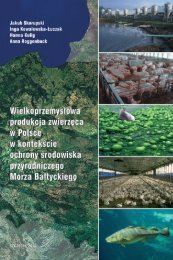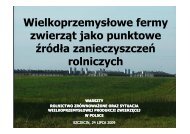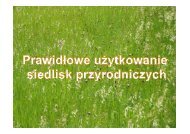best available technologies for manure treatment - Baltic Green Belt
best available technologies for manure treatment - Baltic Green Belt
best available technologies for manure treatment - Baltic Green Belt
Create successful ePaper yourself
Turn your PDF publications into a flip-book with our unique Google optimized e-Paper software.
Best Available Technologies <strong>for</strong> <strong>manure</strong> <strong>treatment</strong> baltic sea 2020<br />
ANNEX F: QUESTIONNAIRE ON THE EFFECTIVENESS OF THE EU INTEGRATED<br />
POLLUTION AND PREVENTION CONTROL DIRECTIVE (2008/1/EEC)<br />
5. How effective are the techniques listed in present<br />
the Reference Document on Best Available Techniques<br />
<strong>for</strong> Intensive Rearing of Poultry (BREF<br />
document from July 2003) to prevent/reduce<br />
N/P leakage from Installations <strong>for</strong> the intensive<br />
rearing of pigs?<br />
- Effective<br />
- Not Effective<br />
- Comment:<br />
6. To what extent are the techniques listed today in<br />
the BREF document implemented in your country?<br />
If you answer “To a low extent” on the<br />
previous question, please comment on why.<br />
- To a high extent<br />
- To a low extent<br />
- Comment:<br />
7. Which current <strong>available</strong> techniques (either<br />
already listed in the BREF from 2003, or other)<br />
are in your opinion the most effective to reduce<br />
N and P at installations <strong>for</strong> the intensive rearing<br />
of pigs, under the regulation of the IPPC directive?<br />
Please list three and comment on the advantages<br />
of each one:<br />
- 1:<br />
- 2:<br />
- 3:<br />
- Comment:<br />
8. What are the main obstacles <strong>for</strong> the large scale<br />
implementation of the techniques you have<br />
listed above?<br />
- 1:<br />
- 2:<br />
- 3:<br />
- Comment:<br />
Questionnaire to COMPETENT<br />
National Authorities<br />
9. How effective is the IPPC Directive in reducing<br />
N/P leakage from Installations <strong>for</strong> the intensive<br />
rearing of pigs?<br />
- Effective<br />
- Not Effective<br />
- Comment:<br />
10. How effective is the IPPC Directive in promoting<br />
Best Available Techniques (BATs) to reduce<br />
N/P leakage from Installations <strong>for</strong> the intensive<br />
rearing of pigs?<br />
- Effective<br />
- Not Effective<br />
- Comment:<br />
11. To what extent are the techniques listed today in<br />
the BREF document implemented in your country?<br />
If you answer “To a low extent”, please comment<br />
on why.<br />
- To a high extent<br />
- To a low extent<br />
- Comment:<br />
12. How are recommended BATs <strong>for</strong> reducing N and<br />
P leakage from installations <strong>for</strong> the intensive<br />
rear-ing of pigs in the IPPC directive communicated<br />
to pig farmers concerned in your country?<br />
- When issuing permits<br />
- At regular monitoring?<br />
- Other?<br />
13. How is it validated that the in<strong>for</strong>mation is<br />
received and used?<br />
- Comment:<br />
14. How is compliance with the recommendations<br />
in the IPPC Directive /BREF document <strong>for</strong><br />
Intensive Rearing of Poultry and Pigs ensured?<br />
- Comment:<br />
15. How decisive is the BREF document <strong>for</strong> Intensive<br />
Rearing of Poultry and Pigs when issuing<br />
permits <strong>for</strong> new installations <strong>for</strong> the intensive<br />
rearing of pigs?<br />
- Decisive<br />
- Not decisive<br />
- Comment:<br />
16. How effective are the techniques listed in the<br />
present Reference Document on Best Available<br />
Techniques <strong>for</strong> Intensive Rearing of Poultry<br />
86








